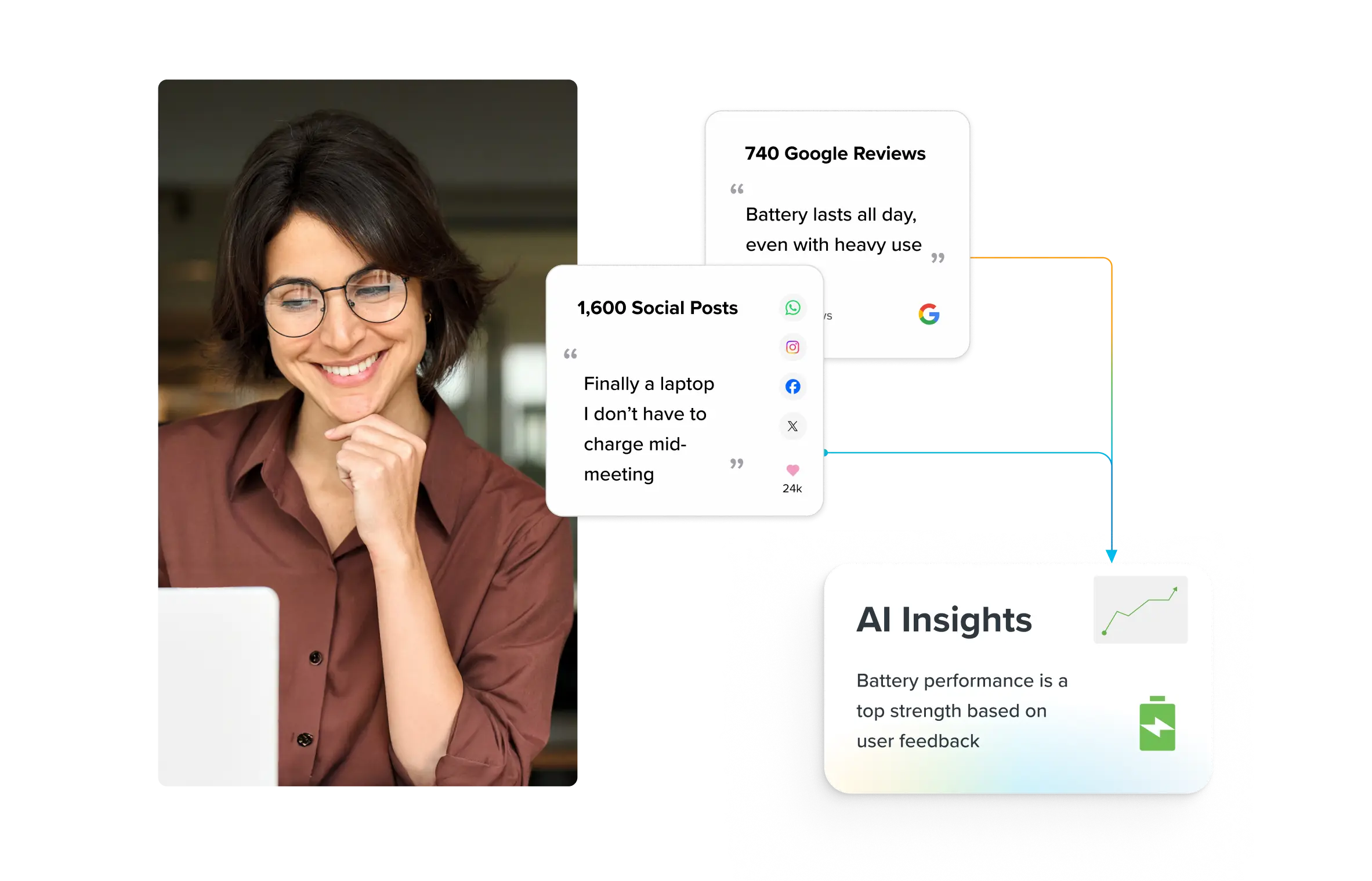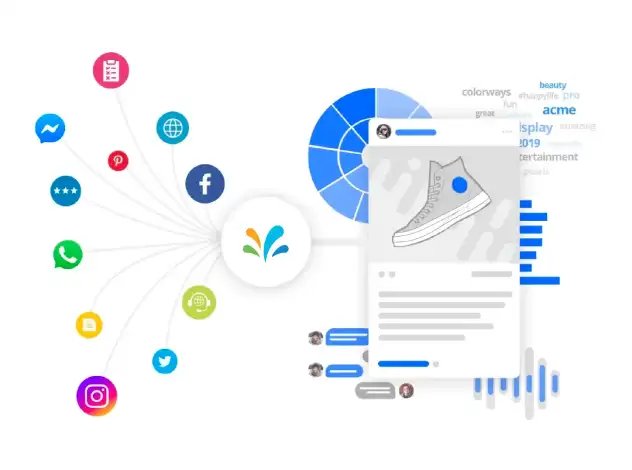Elevate CX with unified, enterprise-grade listening
Sprinklr Insights gives you real-time consumer, competitor and market intelligence from 30+ channels without the noise. Make smarter decisions, strengthen your brand, and stay relentlessly customer-led.

10 Social Listening Strategies for Businesses in 2024
Social listening strategies have emerged as vital tools for businesses looking to stay competitive and responsive in the volatile digital landscape. Monitoring and analyzing online conversations can yield real-time insights into customer sentiment, market trends and competitive dynamics that can help refine everything from marketing campaigns to social customer service, keeping everything relevant and responsive.
What's more, social listening can be key to enhanced customer engagement and brand management - a primary reason why 61% of businesses have an established strategy for social listening and 82% view it as an essential planning component.
Are you behind the curve? Fret not. The information in this blog will help you get started with social listening and inspire you with real-life examples and actionable tips. Let’s dive in.
Social listening strategy for marketing teams
Marketing teams are crucial in shaping brand perception and driving customer engagement. Social listening allows them to gain deeper insights into customer behavior, preferences and market trends. Here are two social listening strategies that marketing teams can leverage:
#1: Monitor brand sentiment for crisis management
Marketing teams can leverage social listening to track the performance of their campaigns in real time. By monitoring mentions, hashtags and relevant keywords, they can gauge public reaction and engagement levels. This immediate feedback allows marketers to adjust their strategies on the fly, optimizing content and targeting their audience to enhance campaign effectiveness.
Example
Look at Weber, for instance. The company chose an unfortunate day to promote a meatloaf recipe. The grill manufacturer sent their recipe-of-the-week email on June 22, 2022, which included instructions for making "BBQ Meat Loaf." This email coincided with the announcement of the death of Marvin Lee Aday, famously known as the rock star Meat Loaf.
After social media backlash, Weber Grills quickly issued a follow-up email, extending their sincerest apologies to the recipients.
"When we shared this recipe, we were unaware of the sad news about the passing of American singer and actor Mr. Marvin Lee Aday, also known as Meat Loaf," Weber explained. "We deeply apologize for this oversight and any distress this email may have caused."
This incident highlights the importance of social listening in brand health management and crisis control. By actively monitoring social channels and timely social media sentiment analysis, Weber’s marketing team prevented a potential PR disaster.
#2: Identify trends for content strategy
Identifying and analyzing emerging social media trends is crucial for keeping your social media content strategy up-to-date and resonant. Social listening enables marketing teams to detect these trends early by analyzing conversations and sentiments around specific topics. These insights can help brands craft engaging content with virality potential. Trending content garners more engagement and boosts your brand visibility.
Example
In 2022, Tariq, a young Asian boy, went viral for his enthusiastic love of corn, earning the tag of Corn Kid. Chipotle was quick to catch the Corn Kid climbing the charts of social media popularity and became the first brand to collaborate with him in an ad campaign. The result? It became their top-performing video on TikTok, Facebook and Instagram, winning the brand its first-ever Shorty Award!
That’s not all. The video's impact extended beyond social media, attracting significant media attention. The Chipotle x Corn Kid partnership generated over 768 news stories and 1.1 billion PR impressions, including features in prestigious outlets like The New York Times. Chipotle’s partnership with Corn Kid is a leading example of how marketing teams can use social listening to keep up with the latest social media trends and capitalize on them.
Social listening strategy for sales teams
Social listening supports lead generation by arming sales teams with granular insights into customer needs, market trends and competitor activities. Here are a few social listening strategies that sales teams can leverage:
#3: Identify leads and prospects
Social listening tools help sales teams identify potential leads by monitoring conversations and mentions related to industry-specific keywords, competitors and relevant hashtags. This enables sales reps to engage with prospects at the right moment when they are expressing interest or pain points related to your or your competitor’s products or services.
There are two ways to approach this:
Follow keywords and hashtags related to pain points
Hashtag tracking leads you to the conversations and discussions around topics that matter to your potential customers. For instance, if your business offers cybersecurity solutions, tracking keywords like "data breach" and "cybersecurity threat" or hashtags like #DataSecurity can reveal discussions where individuals/companies express concerns or face challenges related to these issues.
Sales representatives can jump in, engaging the posters and their community in insightful discussions and offering useful solutions that address their needs. This proactive approach allows you to drive brand awareness and lead generation via social media. It’s about being present in the right conversations at the right time, demonstrating that you understand their problems and are ready to provide valuable solutions.
Track your competitors’ usernames, brand hashtags and product names
Monitoring your competitors' social media activity can provide a wealth of information on potential leads. You can access hordes of potential leads, which include people expressing dissatisfaction with your competitors’ products or services, asking for recommendations or showing interest in alternative solutions.
#4: Competitor analysis
Tracking competitors' social media activities and customer feedback provides critical insights into their strengths and weaknesses. Sales teams can leverage this information for competitor benchmarking. They have all the data they need to position their offerings effectively and anticipate potential queries during the sales process.
Competitive intelligence helps sales teams understand market trends, identify gaps in their offerings and tailor their sales pitches to highlight their unique value propositions.
Social listening strategy for product teams
By leveraging social listening effectively, your product teams can enhance their understanding of customer needs, which guides your product development efforts and helps maintain a competitive edge in an overcrowded marketplace. Here are two specific social listening strategies that you can use:
#5: Validate product ideas and market demand
Reports suggest a lack of proper product-market fit causes 34% of small business failures. To avoid this, before investing resources in developing new features or products, your product team can use social listening to validate ideas and market demand.
By analyzing discussions, sentiments and interest levels around potential concepts or prototypes, your product team can assess whether there is sufficient customer interest and readiness to adopt the proposed solutions. This kind of validation minimizes the risk of launching products that may not meet customer expectations or fail to gain traction in the market.
#6: Ascertain product issues early
Social listening allows product teams to monitor conversations about their products and updates in real time across social platforms, forums and review sites. By actively listening to customer feedback, complaints and suggestions, the teams gather product insights. Businesses can quickly identify emerging issues or pain points that customers are experiencing. Early detection enables prompt action to issues are addressed before they escalate. Timely redressal of customer feedback, improves overall product quality and customer satisfaction.
👉 Related Read: The Product Insights Playbook
Example
Look at Huda Beauty's Overachiever Concealer's launch and subsequent evolution. It showcases how a brand can leverage social listening to refine its product offerings and better meet consumer needs. Initially, the Overachiever Concealer was well-received and enjoyed customer loyalty. However, as with any product in a competitive market, continuous improvement is crucial to maintaining relevance and customer satisfaction.
Huda Kattan, the founder of Huda Beauty, emphasized the importance of understanding customer feedback and monitoring online discussions about their complexion products. The brand identified areas where the Overachiever Concealer could be improved through comprehensive social listening — analyzing comments, reviews and conversations across social media platforms and beauty forums.
One of the key insights gained from social listening was the need to address issues related to creasing. Customers sought a more buildable coverage option. They expressed the need for a concealer that provided a luminous yet matte finish, combining long-lasting coverage with a natural look.
In response to these insights, Huda Beauty launched a new product in 2022 — the #FauxFilter Luminous Matte Buildable Coverage Crease Proof Concealer. The name itself reflects the dual benefits customers were seeking — a blend of luminosity and matte finish that can be layered for customizable coverage without creasing. Kattan humorously acknowledged the paradox in the product name, likening it to a "jumbo shrimp," which illustrates the brand's understanding of the nuanced needs of their consumers.
Social listening strategy for customer service teams
Distraught customers often take to social media to air their grievances. It’s little wonder that customer service teams are usually the first to opt for social listening. Here are two social listening strategies your teams can leverage:
#7: Monitor brand mentions and sentiment
Exceptional social customer service is a cornerstone of modern business success. Customer service teams can use social listening tools to monitor brand mentions and sentiment across various platforms. This involves tracking social mentions of your company, products or services and analyzing the sentiment (positive, negative or neutral) underlying these mentions.
💡 Pro Tip: While monitoring direct mentions, track variations and potential misspellings of your business name, products and services. Distressed users can misspell your name or end up tagging the wrong account. Use wildcard symbols to capture different variations of your keywords (e.g., “comp” for company, companies, etc.)
Example
Consider Deutsche Bahn. As one of Europe's largest railway operators, it receives a substantial volume of inbound messages on social media platforms like Facebook, Instagram, LinkedIn and YouTube. These messages cover various topics, including schedules, service disruptions, and customer inquiries.
Deutsche Bahn implemented Sprinklr Service, a comprehensive platform for managing customer service interactions across multiple social channels. The solution suite includes features like automatic tagging, unified agent desktop and robust reporting.
The platform's unified agent desktop allows Deutsche Bahn's 25 agents to manage nearly 1 million inbound messages annually. This interface consolidates interactions from various channels, enabling agents to respond quickly and effectively.
How did this help Deutsche Bahn?
- Deutsche Bahn experienced a 17% decrease in average case processing time compared to the previous year.
- Agents reduced their average case handling time by 49%, from 10 minutes to ~5 minutes.
Want similar results? Try Sprinklr today 👇
#8: Track customer feedback and complaints
Customer service teams can proactively track and analyze customer feedback and complaints shared on social media, forums and review sites. This involves identifying recurring issues or pain points that customers are experiencing and categorizing them, minimizing response times and resolutions.
💡 Pro Tip: When looking through your online chatter, look for posts that are getting a lot of action — tons of likes, shares and comments. Posts with a lot of engagement are often led by influencers with large followership. By following these posts, you automatically reach influencers popular among your audience. If you have the budget, collaborate with social influencers to boost your brand awareness and credibility.
Example
For instance, M&T Bank sought to enhance its social media strategy. It wanted to effectively communicate its company culture, community involvement and commitment to customer satisfaction. With over 700 branches across the eastern United States, managing voluminous customer feedback and complaints across social platforms posed a significant challenge.
The solution?
Sprinklr Social and Sprinklr Insights. The bank implemented Sprinklr’s two product suites to streamline its social media operations, supercharging its social care and protecting its brand reputation effectively.
The result?
- Social listening for customer insights: Sprinklr's social listening capabilities allowed M&T Bank to monitor conversations across platforms like LinkedIn, Facebook and YouTube. By setting up social listening dashboards, the bank could promptly identify customer sentiments and emerging issues. For example, they could track discussions about service quality, banking products and specific branch experiences.
- Automated tagging and categorization: Using Sprinklr's automated tagging feature, M&T categorized incoming messages related to customer feedback and complaints, which helped with organizing and prioritizing messages based on urgency and topic.
Social listening strategy for executive leadership
For leaders and decision-makers, harnessing the power of social listening can be a gamechanger as it provides invaluable insights into market trends, brand perception and emerging risks. This enables them to make proactive decisions on the back of concrete data. If you’re in this target group, here are two strategies you can use:
Crisis management and risk mitigation
Leadership teams consider social listening critical to crisis management and risk mitigation strategies. By monitoring social media platforms, forums and news outlets in real time, leaders can quickly identify and manage potential crises, such as negative publicity, customer complaints or emerging issues within the industry.
Pro Tip 💡: Set up alerts for spikes in negative sentiment, unusual activity, or increased mentions of your brand or industry. Track keywords related to potential crises, such as “complaint,” “issue,” “scandal,” or “boycott". Using a modern social listening tool, like Sprinklr Insights, can make a world of difference. During red-alert situations, the solution stack uses AI to identify risks to a brand quickly, cutting down response times by up to 70%. It also alerts teams about unusual online activities, allowing fast action to prevent further damage.
Implementing social listening for crisis management enables leadership teams to respond promptly to unfolding situations, manage public perception effectively and minimize the impact of crises on the organization's brand reputation and bottom line.
Example
A woman purchased a rain jacket from The North Face and went hiking in the rain in New Zealand. She later complained that she ended up completely soaked despite the jacket being labeled as waterproof. Her request? "Meet me at the top of the mountain and bring me a new coat."
This video quickly went viral, amassing 10.3 million views. The North Face team responded swiftly, demonstrating exemplary social listening and rapid response. They created a video showing an employee grabbing a new jacket from a North Face store, hopping on a helicopter and delivering it to the woman at the top of the mountain.
This swift and creative response addressed the customer's complaint and turned a potentially negative situation into a highly positive and engaging brand moment. The North Face turned an unsatisfied customer experience into millions of positive impressions, showcasing its commitment to customer satisfaction and agility in handling social media feedback.
This incident serves as a masterclass in using social listening to manage a potential social media crisis, turning it into an opportunity for positive brand sentiment and extensive reach.
Recommended Read: 7 Key Social Media Metrics to Track
#10: Competitive benchmarking
Leadership teams can use social listening to assess the health of their brand and benchmark against competitors in the marketplace. By analyzing metrics such as brand awareness, share of voice and customer engagement levels across social media platforms, leaders gain valuable insights into how their brand is perceived relative to competitors.
Final thoughts
From marketing and sales to product development and customer service, social listening strategies can empower your teams to glean actionable insights, enhance customer relationships and drive strategic initiatives. But harnessing the power of real-time data from social media platforms is not easy. Organizations often struggle to track social conversations, stay competitive, and foster deeper connections with their audience.
This is where Sprinklr Social and Sprinklr Insights can help. They are industry-vetted solution stacks with AI-powered social media management and listening capabilities. With these tool stacks, you can turn unstructured data from 500 million daily conversations across 30+ modern channels into actionable insights to drive business growth. You can connect with your audience across all digital fronts, resolve issues quickly and stay ahead of competitors.
The result? A more innovative and agile business approach that saves time, cuts through the noise and focuses on what truly matters — building lasting customer relationships.










